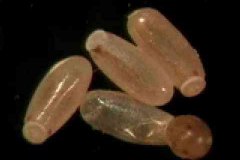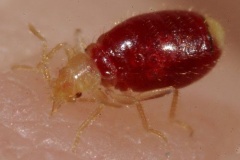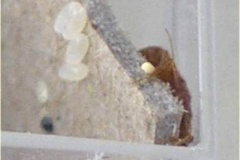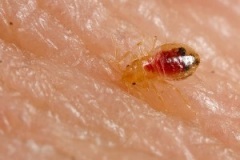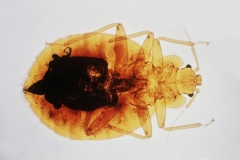Bed Bug Facts
Bed bugs are universal pests of humans and domestic animals, as well as of bats, birds, and various other mammals. The sole food of bed bugs is the blood of warm-blooded animals. Common names used for the bed bug include mahogany flat, chinch, and red coat.
Prior to World War II, bed bug infestations were common. Since the development of synthetic organic insecticides such as DDT and chlordane almost 70 years ago, bed bug infestations in buildings have declined significantly - almost disappeared. In fact, in the United States, bed bug infestations have been exceedingly rare - almost non-existent - until a few years ago.
Today, bedbugs can be found in every State in the United States, and almost every city. Bedbugs are so common now that the federal government considers them almost "epidemic". The National Pest Management Association has declared war on bed bugs and has held bedbug meetings all across the Nation to help educate pest control companies in an effort to help control them.
The most frequent bed bug encountered in the United States is Cimes lectularius, the common bed bug. However, one other bed bug species occasionally found in the southern United States, is Cimex hemiperus, the tropical bed bug. Both of these species are oval, flat and reddish brown. They range from one-fourth inch to five-eighths inch in length. Nymphs and adults have piercing-sucking mouthparts and are incapable of flight. However, small stubby wing remnants can be observed on the adults.
In laboratory tests, bed bugs have been found to carry the causative agents for several diseases, such as anthrax, plague, tularemia, yellow fever, relapsing fever, and typhus. However, there is little evidence that they carry these disease organisms under normal conditions, so they are not considered an important factor in disease transmission.
Occasionally, you might find other bugs which resemble the common bed bug including the bat bug and swallow bug. Both of these species superficially resemble the common bed bug. However, their primary hosts are bats and birds and there are small but diagnostic morphological differences. Problem infestations with these bugs may occur in attics or unused chimneys. Typically, when one host is gone these bugs seek an alternative host blood meal. This is when humans are bitten. It is important to differentiate between the common bed bug and other bugs that feed on bats and birds because control efforts can be targeted at the wrong sites and infestations can continue.
Bed bugs have an odor that in pronounced and in severe infestations has been described as an "obnoxious sweetness". Harborage sites are marked by brown or black spots of dried blood on surfaces where bugs rest.
Bed bugs are very hardy insects. Both adults and nymphs can survive prolonged periods without food or under adverse temperature conditions. Adults can live for a year or longer without feeding and can survive over winter in an unheated building. Nymphs are not as hardy as adults, but they can survive for considerable periods under adverse conditions.
An adult bed bug is about 1/5 inch long and 1/8 inch wide. Its reddish brown to mahogany-colored body is greatly flattened and oval shaped. After feeding, the bug's body enlarges considerably, becoming longer and much less flattened. Although the body is covered with tiny hairs, these hairs are so small that they are almost invisible to the naked eye, so the general body appearance is shiny. Bed bugs have piercing-sucking mouthparts that enable them to pierce the skin and suck blood from their hosts.
Bed bug females lay between 200 and 500 eggs during their lifetime in batches of three to four eggs per day. These eggs hatch after 6 to 17 days. Nymphal bed bugs molt five to six times before becoming adults. Under the best conditions, the life cycle is complete in four to five weeks, but since ideal conditions are rarely found it can take four to five months. Adult bed bugs can live 10 months or more without food. Nymphal bed bugs are known to survive for more than two months without feeding.
Bed bugs tend to live in clusters similar to German cockroaches. Adult bed bugs generally travel 15 to 20 feet, or less, from their harborage sites. Common bed bugs feed on human blood just below the surface of the skin with their piercing-sucking mouthparts. Those bitten by a bed bug may develop small, white to red, hard welts at the bite site. These bites itch intensely.
Bed bugs feed exclusively at night. They take approximately three to five minutes to engorge on blood. Once feeding is complete, they return to their harborage. Feedings take place every few days and nymphs require approximately six blood meals for complete development. Humans are the preferred host for the common bed bug, but it will feed readily on other animals, such as poultry, mice, rats, canaries, dogs, and cats, when necessary. Normally the bugs feed at night, but they will feed during daylight hours in places such as theaters, offices, and rest rooms that are not ordinarily used at night.
1. Perform an extensive bed bug inspection
This includes identifying the bed bugs, assessing the structure and considering your treatment strategy. Bed bugs generally hide in cracks and crevices during normal daylight hours. They enter such areas easily because of their extremely flattened bodies. Typical hiding places are in the folds and tufts of mattresses, coils of springs, cracks and hollow posts of bedsteads, and upholstery of chairs and sofas. However, they are not restricted to these places. In heavy infestations, bed bugs are frequently found in places such as behind loose wallpaper, behind pictures on the wall, under door and window casings, behind baseboards, and even in light fixtures or medicine cabinets. When inspecting for bed bugs, you must look in any place that offers darkness, isolation, and protection.
2. Prepare your home for bed bug treatment
Bed bugs are tough to control. They hide in many places - in beds, closets, furniture, behind pictures, in tiny cracks in the walls, and even inside the walls - so inspections and treatments must be thorough. Before you can treat your home for bedbugs, you must prepare it.
Disassemble your beds - remove all sheets, blankets, mattress covers, pillowcases, etc. from your beds and wash thoroughly. Fold them and place them in plastic garbage bags. Do not put them back on the bed until after the treatment.
Remove everything from bedroom and closets. Your closets must be empty. Empty all dresser drawers and night stand drawers. Take everything out of nightstands and other furniture near the beds. Dresser drawers and nightstands must be empty. Remove all clothing, toys, boxes, etc. from bedroom floors. Place items in the living room.
Wash ALL clothing, towels, and other linens. This means everything. After washing, place the clean items inside plastic storage bins or plastic garbage bags. Store them in your living room until after treatment.
Vacuum floors, furniture, inside closets, dresser drawers, and bed stands. Also vacuum mattresses and box springs. Dispose of vacuum bag outdoors.
Move furniture away from walls. Make sure you can get into all closets. If possible, move bedroom furniture away from walls so there is a 3 foot space between the furniture and walls. You need plenty of room to be able to treat and inspect.
Pull carpet edges back from walls. Being careful, take a pair pliers and gently grab the corners of the carpet and pull the carpet back about 1 foot. Do this one wall at time during treatment. After treatment as described below, replace the carpet and tuck under the baseboards. If you do this 1 wall at time you will not usually need to re-stretch the carpet.
3. What to spray and how to treat for Bed Bugs
Your thoroughness in your treatment is as important as your thoroughness during inspection. Beg Bug treatment can begin after you remove the bedding, disassemble the bed, empty nightstands, pull up carpet edge and vacuum.
Dust the wall voids. Bed bugs can often travel from room to room, especially in apartments, hotels and condo's. They travel along electrical wiring and plumbing lines. Specifically treat wall voids with a hand duster either by removing wall switch plate covers and/or drill access holes discreetly between studs. Cimexa Dust or Delta Dust are excellent choices for void applications. It kills populations in walls and voids and creates a repellent, hostile environment which reduces the likelihood of bed bugs traveling through voids to other areas. Use a small hand type duster to "puff" insecticidal dusts into these areas. A light coating is all that is needed. To much dust and the bed bugs will just crawl around it.
Dust every crack and crevice. Every crack and crevice, electrical switch plate, wall switch - EVERYTHING - within 10 to 15 feet of the bed should be treated, particularly those closest to the bed. Use the "running method" of moving the application tip along the length of the crack. Look for cracks from the ground level to the ceiling as you treat each section of the room. Use Cimexa Dust or Delta Dust. If you make a mess, simply wipe it up. To much insecticide is better than too little for bed bug control.
Treat mattress box spring and furniture voids with Cimexa Dust or Delta Dust. Turn bed box springs over and remove the cloth cover seal. Thoroughly inspect and treat the box springs area with insecticidal dust. After treatment replace the cloth cover seal with staples or screws. Hollow bed-frames, platforms, headboards and any other voids discovered during inspection should also be treated where possible. The upper mattress can be sprayed and treated with Bedlam Plus, Zenprox or Sterifab.
Apply residual Bed Bug Insecticide Spray. After every crack, crevice, switch plate, electrical switch, baseboard, box springs, mattress, etc, has been treated and everything is put back, it is time for the residual treatment. Using a hand held sprayer such as the Chapin Sure Spray apply Optimate, Cy-Kick, Suspend SC or Demand along the baseboards in the bedroom and closet, under and around the bed, behind the headboard, inside bed stands etc.
Do not spray these products directly onto the Mattress or box spring, only Bedlam Plus, Zenprox or Sterifab should be used on mattresses and on box springs. After spraying, wait until all surfaces are dried before putting everything back and continuing your treatment.
Encase Mattresses and use bed bug interceptor traps on bed frames. After everything is put back and all pesticides are dried, vacuum the area again to remove any dead or dying bedbugs and to pick up any spilled dust or pesticide. Be sure to throw the vacuum cleaner bag away outdoors. A thorough treatment is essential to achieve adequate control. It is usually desirable to apply insecticides for bed bugs early in the day, so that insecticide spray residues will have several hours to dry, or dusts will have time to settle, before the room will be used again for sleeping. As a safety consideration it is particularly important to dry and cover mattresses completely before they are reused. A mattress encasement such as The Elite Zippered Mattress and Boxspring Encasement should be used to cover and conceal the mattress and the boxsprings. It is important to use a quality zippered encasement (cover) with a special zipper closure to make sure that bedbugs do not crawl out of the zipper opening.
Bed Bugs can re-infest your freshly treated bed, so be sure to stop them from crawling up the bed posts by using Climb-Up Bed Bug Insect Interceptors. The Climb-Up Insect Interceptor is a small dish that is placed under the bed post and captures bedbugs in a a powder coated ring. These type of bed bug traps are very effective and should be used on every bed to help make a complete bed bug proof bed.
Monitor Bed Bug movement with Traps. Bed Bug traps don't work to control bed bugs - they only monitor bed bug movement. Try using Catchmaster 288i Professional Bug Traps by placing them against walls, behind furniture, sticking them under bedframes (yes they work upside down), and anywhere you think bed bugs could be crawling to get back to the bed. Inspect these traps every few days. If you capture bed bugs, then you may have to retreat and do this entire procedure over again. If the traps are empty, then pat yourself on the back for a job well done, but don't think that bed bugs are gone forever. They could be walking around the trap or just waiting for the comforter to hit floor before they climb back into bed!
The best bed bug traps are those that are used under the bed. The Climb-Up Bed Bug Interceptor is placed below the bed frame rollers or legs. The Climb-Up prevents bed bugs from being able to crawl either from the bed to the floor or from the floor to the bed. The Climb-Up works very well at isolating the bed from the floor and making it bed bug proof. As long as the comforter or some other linen is not touching the floor, then the bed is protected.
Other bed bug traps include Pro Pest Bed Bug Monitor. These bed bug traps are actually mattress traps. They are placed in between the mattress and box spring to capture bed bugs.
To use heat or not to heat? While not always successful, there are other methods of bed bug control. For example, using heat above 98 F is lethal to bed bugs. This type of treatment should usually be peformed by an experienced company since great damage can be done to walls, furniture, flooring, etc, not to mention that you need the proper equipment to be able to perform it. If you are interested in hiring a company to perform a heat treatment, contact us for recommendations for companies in your area.
Go here to read the rest:
How To Get Rid of Bed Bugs Fast - epestsupply.com

 Residence
Residence  Location
Location 

